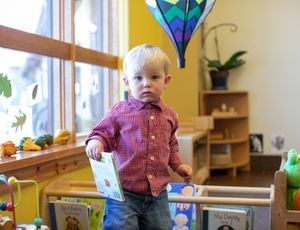We might find ourselves in power struggles with our toddler more often than we would like, and especially when we are in a rush. Change is hard for most humans, but especially for toddlers. Big and small changes are often a challenge for them, and they will be very clear about communicating it to you. In this month´s article, we will discuss certain things we can do in advance to help them navigate changing activities during their daily routine, and making each transition go smoothly and without difficulty.
When we talk about making transitions smoother, we are referring to the multiple shifts during the day. For instance, getting ready to go outside the home, changing clothes, brushing teeth, going to sleep, cleaning up a workspace, and getting ready to have a snack or family meal. Transitions can be stressful for toddlers for many reasons. Usually it is because they need a change of activity before they want it. Transitions can have multiple steps that can be hard to remember, and a child might not even expect to have to adapt to something suddenly.
Toddlers have big feelings and will let you know if a transition is not well received. The way we act before and during a transition will determine if it will become a power struggle, a meltdown, or if it will flow to the next part of the day without any negative impact on their daily rhythm.
Things to Keep in Mind for Smoother Transitions
Consistency. Create and keep a consistent routine. It does not have to be perfect or have a fixed schedule. It just needs to have a constant flow during the day. Toddlers thrive on routines since it gives them a sense of security. Your child will know what to expect. There will be days where routines will not be possible for particular circumstances, for instance, attending a birthday celebration at someone’s house. In this scenario, the best route is to tell your toddler in advance why this day will be different and what it is going to look like. Before any transition, give him a heads up of what’s going to happen using simple words, and going straight to the point will make him feel calm.
Give choices. Toddlers love having a sense of control over their life. Offer your toddler simple choices to give him a sense of autonomy. For instance, “It’s time to change clothes. Would you like to take off your socks or shirt first?”
Use the same place in the house. It is not enough to set a rhythm of activities during the day; it also needs to be done in the same place every day. For instance, even if your child always changes his clothes before breakfast, if he does it one day in the kitchen, and another day in the bathroom, and the next day in his room, then it will be confusing for him since there has not been an assigned spot for that transition. He knows what is next, but he does not know where, and that might make him feel anxious or have no interest in doing it.
Slow down. Nobody likes to be rushed. Children will feel it if we are stressed and in a hurry, and they will pick up on it and make themselves feel anxious, which won’t lead to speeding things up. On the contrary, they often cry and let you know they are not comfortable being rushed. Plan ahead of time; if you know your child takes 15 minutes to dress, try to wake him up a little bit earlier so he has enough time to change clothes.
Give Cues. Let your child know which part of the day is ending and which one is beginning. You can use different sounds or visual cues. For instance, clapping when its time to go outside, sitting on the rug when it's time to tell a story, leaving the pajamas on the bed for him to see when it is time to take a bath, etc.
Avoid bribes or any external motivation. Also avoid offering your child prizes if they go through transitions without crying or complaining.
He will get used to the daily routine.
Validate feelings. Acknowledge how your toddler is feeling, be calm and support him, and understand that change is hard. Hear him and offer comfort. Boundaries and routines mustn't slide; children need the security of a daily routine. When we are patient and hear them out, we are giving them the message that is okay and safe to feel whatever they are feeling, that they are trusted, that they can be themselves even in the darkest situations, and that all feelings will pass and they will survive them.
Additional Ideas
Routine Cards. Take pictures of your toddler in different parts of your house that symbolize a transition. For instance, using the toilet, lying on the bed, or holding a book. Print them on cardstock, laminate them, and use a small binder ring to put them together. Show your toddler what transition is next on the card. He will be very interested in looking at a picture of himself, and it will be easier for him to cooperate.
Songs and Rhymes. Using different tones of voice and different inflections with toddlers usually get their attention, and it is easier to get them happily engaged with the activity. Take advantage of all those nursery rhymes you know and change the lyrics as you need depending on the transition. After your toddler hears that tune multiple times he will be able to sing it while he flows through the transition.
Video of the Month
Transitions by Montessoriguide.org
Grab your headphones and watch this beautiful, 20-minute video where you will be able to observe multiple transitions during the daily routine in a Montessori environment, and how children cope with them after doing them consistently for many days.
Link to watch it at vimeo.com:
https://vimeo.com/78830768
Have a Little Extra Time?
Practice this song from “This Reading Mama” for the transition of changing clothes and getting ready. You can also use it for other parts of the day. Adjust the lyrics, and your toddler will be engaged in the activity as soon as he hears your singing and feels your good vibe about the transition.
This is the Way
(Tune: Mulberry Bush)
This is the way we put on our shirt,
Put on our shirt,
Put on our shirt.
This is the way we put on our short
So early in the morning.
(Verses: Put on our pants, shorts, hat, shoes, etc).
If you want to read and practice more songs, visit this amazing article with multiple suggestions for you to sing during transitions.
https://thisreadingmama.com/20-songs-that-add-rhyme-to-your-routine/



